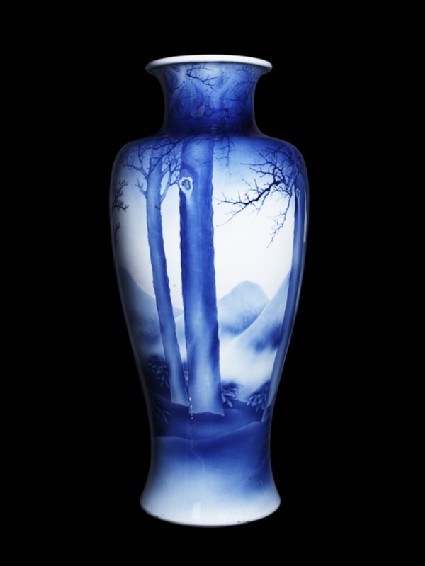Browse: 87 objects
- Reference URL
Actions
Vase with winter landscape
-
Description
In the mid 19th century, the feudal shogunate ruling Japan was abolished and a modernised government was established. As part of an effort to open up Japan to the West after a long period of national isolation, the new Meiji government actively encouraged artists to show their works in competitive, national and international Exhibitions.
This grand vase was made by the potter Miyagawa Kōzan (Makuzu) (1842-1916) who was one of the most prominent Japanese artists of this era. He won several prizes when exhibiting his works in national and international Exhibitions, and was greatly admired in Japan and abroad. Although Kōzan also produced ceramic works using earthenware and stoneware, this vase is an example of his works in porcelain, for which he is most famous. The vase was probably made for an exhibition and illustrates the artistic exchanges of the period. Although the landscape shown is a Japanese one, the misty effect of the blue glaze copies works from the Royal Copenhagen Porcelain Manufactory. This Danish company was itself greatly influenced by Japanese ceramics.
Kōzan’s work can be dated stylistically, as well as by differences in the seal-marks he used at various times. It is therefore usually possible to put his works in sequence and see developments in style and technique over time throughout his career.
-
Details
- Associated place
-
Asia › Japan › Honshū › Kantō › Kanagawa prefecture › Yokohama › Ota › Makuzu kiln-site (place of creation)
- Date
- c. 1910
- Artist/maker
-
Makuzu kiln (1871 - 1959) (potter)
- Material and technique
- porcelain, thrown, with underglaze painting in blue
- Dimensions
-
86 cm (height)
38 cm (diameter)
- Material index
- Technique index
- Object type index
- No. of items
- 1
- Credit line
- Purchased with the assistance of the Story Fund, 2000.
- Accession no.
- EA2000.47
-
Further reading
Impey, Oliver, and Joyce Seaman, Japanese Decorative Arts of the Meiji Period 1868-1912, Ashmolean Handbooks (Oxford: Ashmolean Museum, 2005), no. 10 on p. 24, p. 8, illus. pp. 24-25
Glossary (5)
earthenware, glaze, porcelain, stoneware, underglaze painting
-
earthenware
Ceramic material made of clay which is fired to a temperature of c.1000-1200⁰c. The resulting ceramic is non-vitreous and varies in colour from dark red to yellow.
-
glaze
Vitreous coating applied to the surface of a ceramic to make it impermeable or for decorative effect.
-
porcelain
Ceramic material composed of kaolin, quartz, and feldspar which is fired to a temperature of c.1350-1400⁰c. The resulting ceramic is vitreous, translucent, and white in colour.
-
stoneware
Ceramic material made of clay which is fired to a temperature of c.1200-1300⁰c and is often buff or grey in colour.
-
underglaze painting
Painting applied to ceramic material before a transparent, or monochrome or coloured glaze for Islamic objects, is applied. The technique was initially developed in China.
Location
Objects are sometimes moved to a different location. Our object location data is usually updated on a monthly basis. Contact the Jameel Study Centre if you are planning to visit the museum to see a particular object on display, or would like to arrange an appointment to see an object in our reserve collections.
Publications online
-

Japanese Decorative Arts of the Meiji Period
Very large porcelain vase decorated in underglaze blue with tall trees and bamboo in winter. Signed in underglaze blue on base: Makuzu Kōzan sei.
Kōzan was making very large vases from the 1890s onwards. At Chicago in 1893 he had exhibited an enormous stoneware vase; the porcelain vases of this sort of size appear to date from about 1910-1915.
Galleries
© 2013 University of Oxford - Ashmolean Museum







